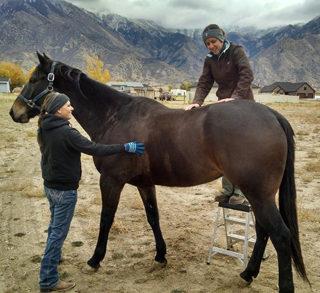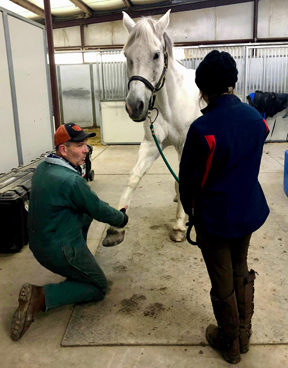Alissa Grover

Photo by Clint Grover
Alissa Grover, left, palpates the lumbosacral joint of a barrel racer named Sadie, while Sadie's owner, Stacey Lake, steadies the horse. Asked how chiropractic is done on large animals, Grover said being quick with adjustments is the key to exerting the power necessary.
Since becoming a chiropractor eight years ago, Dr. Alissa Grover has worked almost exclusively on animals, practicing out of Utah veterinary clinics that contract for her services. This week, she's opening her own place — a move facilitated by a new state law that authorizes certified animal chiropractors to practice without veterinarian involvement.
The legislation, SB 114, was introduced in January, passed the Legislature in February and signed by the governor in March. At no point were any objections recorded, a notable development for a scope-of-practice question with the potential to produce conflicts between health professions.
Acknowledging that the topic is controversial in the veterinary community, Dr. Kara Tassone, president of the Utah Veterinary Medical Association, explained that the UVMA views the law overall as strengthening patient protections. That's because in order to practice on animals, Utah chiropractors now must be certified by the American Veterinary Chiropractic Association. Before, they were required only to complete an AVCA- or state-approved course in the subject to work on a patient referred by a veterinarian.
"All I want, as a veterinarian, is for my patients to be well taken care of by the best person to take care of them. Sometimes, that's not me," said Tassone, who works in emergency medicine.
AVCA certification is available to licensed veterinarians and doctors of chiropractic who complete a minimum of 210 hours of coursework in animal chiropractic and pass an exam. In general, Tassone said, veterinarians receive little to no training during veterinary school in the chiropractic approach, also known as spinal or musculoskeletal manipulation.
Meanwhile, their clients are seeking it out. "It seemed like people were seeing their [own] chiropractor and were saying, 'Hey, my dog's sore; can you check them out?' " Tassone said. " ... We have a whole state full of people who want it. People are seeking it under the table."
In choosing not to contest the legislation, the political climate, too, was a factor for the UVMA. With a governor and legislature favoring deregulation, she said, "Our focus wasn't on protecting our turf but on making certain our patients were being treated in a safe manner."
The bill sponsor, Sen. Scott Sandall, is a farmer and rancher. He said the subject made for "one of the easier bill files that I was able to run, and honestly, I think it promotes business. I don't think there needs to be overregulation in what we do in business, and most of my colleagues agree with that."
Asked how the bill originated, Sandall recounted: "A chiropractor who was working on animals approached me and said, 'Why do we have to have a referral from a veterinarian? We're not using any anesthesia, we're not using any [drugs]. All we're doing is manipulating the spine.' I was like, 'You know, that makes a lot of sense [to drop the referral requirement].' "
Sandall said state policymakers have wrestled in the past with other veterinary scope-of-practice issues that were stickier, such as teeth floating, a dental procedure in horses in which sharp points and edges are filed down.
"It came down to, if you're going to anesthetize an animal, you should have the training of a veterinarian to perform that work," Sandall said. "This [chiropractic treatment] didn't fall under that."
Regardless of whether anesthesia is involved, veterinary communities in other states have been less willing to cede the care of animals to others, even other health professionals. In California, for example, physical therapists have for years been seeking legal authorization to work on animals with indirect supervision by or independently of veterinarians.
In Utah, with no objections from either the UVMA or the state veterinary licensing board, legislation to eliminate the veterinarian referral requirement passed swiftly. Recordings of committee hearings in the House and Senate, and of votes taken by the full chamber, show that lawmakers had few questions, beyond wondering how someone could manage to manipulate the spine of an animal as big and strong as a horse. No one from the public commented.
Utah is only the fifth state in the U.S. to allow qualified chiropractors to treat animal patients without veterinary oversight or referral, according to information from the American Veterinary Medical Association. The other states are Arkansas, Colorado, Minnesota and Oklahoma. (Some states do not allow chiropractors to treat nonhuman patients at all.)
State has five certified animal chiropractors to date
AVCA's "find a doctor" online tool lists two AVCA-certified practitioners in Utah: Grover, the chiropractor who is opening her own practice, in Bountiful; and Dr. James Israelsen, a veterinarian with practices in North Logan and Providence. (Sandall said he doesn't recall the name of the practitioner who asked him to eliminate the referral requirement but it wasn't either of them.)
According to AVCA Executive Director Leslie Means, the state has a total of five certified animal chiropractors; not all appear in the organization's online search tool. Certificants include Dr. Kim Henneman, who in 1993 became Utah's first AVCA-certified veterinarian. The number of animal chiropractors in Utah might soon grow: Israelsen said he knows of two chiropractors in the state who are pursuing certification.
Israelsen with Cato

Photo by Audra Olsen
Dr. James Israelsen assesses mobility in the shoulder of a patient, Cato, before adjusting the horse's shoulder. Cato's owner stands by.
Israelsen is a former president of the AVCA and co-chairs the group's Legislative Committee. He wasn't involved with the Utah legislation, he said, but he likes that AVCA certification is a centerpiece of the law.
Israelsen, like Tassone, recognizes that some veterinarians may dislike eliminating the referral mandate. "I think veterinarians will be a little off-put by this because it does seem like we're turning over something that is animal-related to a different profession," he said, "but one of the challenges when you have a law that requires veterinary referral or supervision is that veterinarians aren't trained in chiropractic in vet school. We might have very brief exposure to it as a treatment modality, but we're asking a veterinarian who is not trained in chiropractic to assess that a doctor of chiropractic is appropriately adjusting an animal."
Being asked to make that judgment carries weight and even legal responsibility, he said: "It does create some liability concerns for those veterinarians, because the vast majority of veterinarians will not have a way to assess it — whether it was an appropriate adjustment, whether it was safe for the animals and whether they are interpreting the adjustment correctly. We're just not trained for it."
He added, "To my knowledge, it's not illegal for a veterinarian to do a chiropractic adjustment on an animal without any training, which I'm not sure I agree with."
Israelsen said he was motivated to become certified in animal chiropractic about 15 years ago, not long after he opened a practice, where he provides care for horses and small animals.
"You get out of school and you're pretty sure you can fix everything, and then you start to realize all of the lameness exams in the world don't make that horse move correctly," he said. "I started to think about what else might be effective in helping my patients." He considers the therapy complementary to conventional medicine.
Grover, the AVCA-certified practitioner in Utah about to open her own clinic, said she knew before becoming a chiropractor that she wanted to work with animals. She considered veterinary school until she realized, "I don't want to do surgeries. I don't want to give shots. I don't want to euthanize animals."
At that time, she and her husband lived in Davenport, Iowa. He was attending chiropractic school, where he met a classmate thinking about becoming an animal chiropractor. When her husband told her about that line of work, Grover recalled, "It was like the heavens opened up and the angels were singing. This is where I need to be!"
Grover said she pursued certification in animal chiropractic and a doctor of chiropractic degree concurrently, obtaining certification in 2012 and the degree six months later.
After school, the couple settled in Utah, where Grover practiced out of several veterinary clinics as a contractor.
The new law, combined with the ongoing coronavirus pandemic, spurred Grover to strike out on her own. The pandemic was a motivator because, Grover said, she's not a fan of the curbside patient drop-off method adopted by most veterinary clinics to limit indoor foot traffic. "I like having the owner there while I'm working on the animals," she said. "I've had a lot of people interested in having me adjust them and their animals."
Grover noted that the previous state law did not preclude starting her own animal chiropractic clinic. "It's just that I would have had so many more hoops to jump through, with having to reach out to every single veterinarian for every single patient that I saw," she said.
She called the earlier requirement for a referral "somewhat ironic" because only rarely would a veterinarian voluntarily send her a patient. "Ninety-nine percent of the time, the client was seeking it out, found me, then we had to reach out to their primary vet for the referral. Kind of backwards, right?" she said.
Still, she said she has no intention of operating completely separately from veterinarians now. "I love that collaboration," she said. "Just because I'm going to be on my own, I'm not planning to say all of a sudden, 'You don't need to see your vet.' I still see so much value in having a regular veterinarian see your animal. They do so much more than I do.
"In my training," she added, "I have been trained to discriminate between, 'This is a chiropractic issue, and this is not.' "
Grover also sees herself as a liaison for those who prefer alternatives to conventional medicine. "I can't tell you how many people are anti-medical around here," she said. "They say, 'I'd rather not see a vet or a regular doctor; I'd rather go see a massage person or a holistic medical person.' I can be an advocate for veterinarians in my practice."
'We encourage them to work together'
Since the AVCA was established in 1989, it has certified nearly 1,500 doctors, according to Means, the organization's executive director. Of those, 778 have active certifications.
Maintaining certification requires 30 hours of continuing education every three years, which Israelsen said is comparable to the hours of CE required to maintain his veterinary license in Utah.
The group's leadership is about equally divided between doctors of chiropractic and veterinarians. Among certificants, Means said 360 are DVMs, two of whom were chiropractors first. The group's late founder, Dr. Sharon Willoughby Blake, was a veterinarian who later obtained a chiropractic degree.
There are five AVCA-approved animal chiropractic education programs in the U.S., one in Canada and one in Germany. At one time, AVCA provided animal chiropractic education but no longer does. Its role is in administering the certification exam.
As an organization composed of veterinarians and chiropractors alike, Means said, "Absolutely, we encourage them to work together. Certainly, we feel like there's harmony between the two professions."
Correction: This story was changed to reflect that Utah has more AVCA-certified practitioners than are listed by its online search tool.